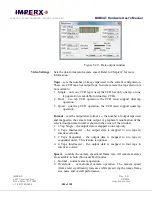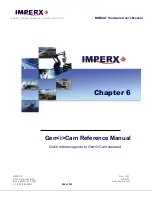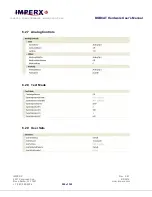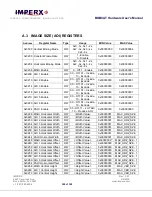
CAMERAS FRAME GRABBERS IMAGING SOLUTIONS
BOBCAT Hardware User’s Manual
IMPERX
Rev. 2.0.7
6421 Congress Ave.
4/8/2014
Boca Raton, FL 33487
www.imperx.com
+1 (561) 989-0006
285 of 329
6.1
INTRODUCTION
The BobCat series of GigE Vision cameras are fully compliant with the Gen<i>Cam standard. The
cameras include an embedded camera description file ( XML ) that contains all of the information
required to automatically map a camera’s features to its internal registers. The Gen<i>Cam
standard defines the syntax and semantics of the camera description file. It also defines a
mechanism for the user to configure the camera by reading/writing the camera registers associated
with the features.
The camera description file ( XML ) contains a set of nodes where each node represents a feature
of the camera. Each node has a set of attributes that define the feature including a description, type
( ie. integer, boolean, etc. ), register address, minimum value, maximum value, increment, etc. All
of this information is contained in the XML file. The XML file is transferred from the camera to
the host application when a connection is first established. The host application then parses the
XML file and presents the user with a “node tree’ representation.
The BobCat series of cameras include a full-featured host application, called PureGEV, which
allows the user to connect to a camera, view/save images from the camera and control its features
via a “node tree” user interface representation.. Please refer to the PureGEV Quick Start Guide for
details on how to install and use the PureGEV application.
A “node tree” is a tabular list of all of the camera features ( that were described in the XML file ).
The user can control a feature by simply clicking on it with the mouse and editing the field. Some
features provide drop down menu lists, while others support direct data entry. Features that are
read-only ( ie. status indicators ) are de-highlighted and un-editable. Some features depend on the
state of other features. For example, the GainAutoBalance is only active if the
SensorDigitizationTaps is equal to Two. Some features are locked while image streaming is active.
For example, the PixelFormat feature can only be changed while images are not being streamed.
The following tables illustrate the node tree as it is displayed by the PureGEV application. For a
detailed description of the features, please refer to Chapter 2.






























